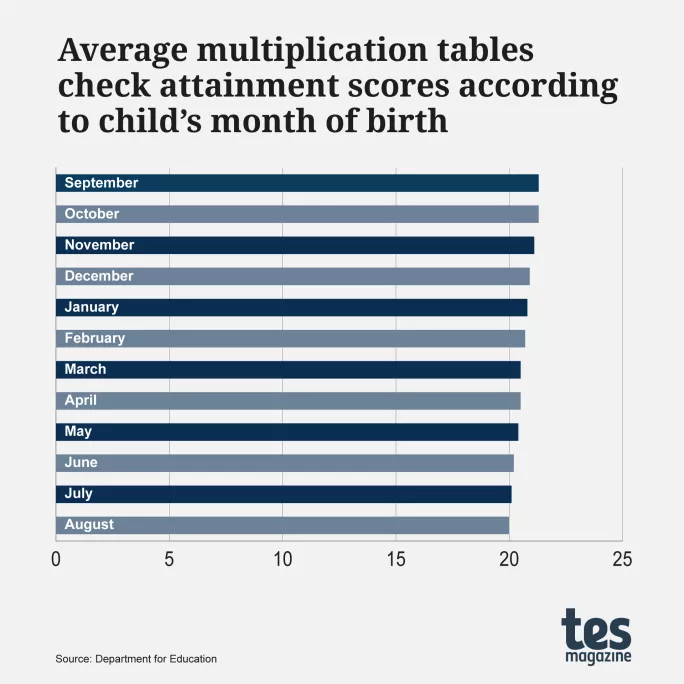Multiplication tables check 2024: 6 insights for school leaders

Today the Department for Education released the national data on this year’s multiplication tables check (MTC).
The assessment - which determines whether Year 4 pupils can fluently recall their times tables up to 12x12 - was made statutory in 2022, so this data is the third consecutive release of its kind. As previously, pupils had six seconds to answer each of the 25 questions.
This year, 96 per cent of eligible pupils took the online test - the same proportion as last year.
Here are the key trends you need to know.
1. The average attainment score is up
Nationally, the average attainment score for this year’s MTC was 20.6 out of a total of 25.

This is an increase of 0.4 points from the 20.2 average attainment in 2022-23, and a 0.8 point increase on two years ago, when the average was 19.8.
As ever, there was a small difference in the results achieved by boys and girls, with the average attainment score for boys reaching 20.9, while for girls it was 20.4. This follows the trend we have seen in previous years.
2. The percentage of pupils scoring full marks has also grown
There’s more good news: the percentage of pupils achieving a full-point score of 25 also rose, from 29 per cent last year to 34 per cent in 2024. That’s a significant 7 per cent increase on 2021-22, when that number was 27 per cent.

The most common score for both boys and girls was 25.
But interestingly, boys tended to do better only at the very top of the score sheet: 35 per cent of boys, compared with 32 per cent of girls, got full marks this year, while 12 per cent of girls and 13 per cent of boys got a score of 24.
3. Disadvantaged pupils continue to score lower than their peers
Less welcome news is that the disadvantage gap persists, with disadvantaged pupils scoring an average of 18.9 compared with the 21.3 average of those not known to be disadvantaged.
But that gap has narrowed slightly, from a difference of 2.6 points both last year and in 2021-22, to 2.4 points in 2024.
However it is worth noting that fewer disadvantaged pupils (94 per cent) took the test than those not known to be disadvantaged (97 per cent) because a larger proportion of disadvantaged pupils were recorded as working below the level of the assessment.
4. Regional disparities remain
London remains the highest-performing region this year, with pupils in the capital receiving an average of 21.5 points.
It sits atop a stark regional attainment gap: notably, no other region saw an average of 21 or more - the North East and the West Midlands were the next highest scoring, each with 20.9.
Meanwhile the South West continues to be the lowest-performing region, with an average of 20.3 - though this year, the South East joins it, despite seeing a 0.3 point increase on last year.
The East of England and the East Midlands also scored low, with an average of 20.4.
At a more granular level, the attainment gap between local authorities was even starker. Richmond in London was highest with 22.4, while Norfolk was lowest with 19.2.
- Suspensions and exclusions up by a third in a year
- Pressure on primary school leaders ‘unsustainable and unfair’
- What is the multiplication tables check?
5. Free schools perform best
By school type there are some notable variations in outcomes. Overall, free schools performed best with an average of 21.6, from a total of 11,685 pupils who sat the MTC, while convertor academies were second at 20.9 as an average outcome.
Sponsored academies scored the lowest average attainment at 20.3, although from a far larger pupil cohort size of 72,911.
Academies and free schools combined achieved an average of 20.8, slightly higher than the local-authority-maintained school average of 20.6 - again from an even larger cohort size of 359,174.
6. The older the child, the better they perform
Finally, if schools want to know which pupils will need extra support or not, then birth month could be a good place to start.

Specifically, data for this year’s MTC shows that those born in September achieved the highest average score of 21.3, with each month thereafter following on, down to August-born children achieving 20.
This corresponds with numerous other assessment outcomes, such as the phonics check, in terms of determining likely outcomes.
For the latest education news and analysis delivered every weekday morning, sign up for the Tes Daily newsletter
Keep reading for just £1 per month
You've reached your limit of free articles this month. Subscribe for £1 per month for three months and get:
- Unlimited access to all Tes magazine content
- Exclusive subscriber-only stories
- Award-winning email newsletters
topics in this article



